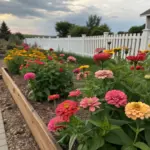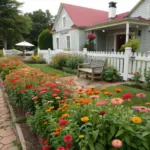6. The Pollinator’s Paradise

Let me tell you about my absolute favorite garden design – what I like to call the Pollinator’s Paradise! After 15 years of gardening, I’ve learned that creating a buzzing ecosystem isn’t just beautiful – it’s crucial for our environment. The secret lies in understanding how different pollinators interact with various flower shapes and sizes.
Selecting the Perfect Flower Combinations
I discovered (the hard way!) that single-bloom zinnias are pollinator magnets. These open-faced beauties provide easy access for bees and butterflies to reach the nectar. I love pairing them with branching sunflowers like ‘Autumn Beauty’ or ‘Soraya’. The multiple heads on each stem mean more landing spots for our buzzing friends!
My go-to combination includes:
- California Giants zinnias (they grow 3-4 feet tall)
- Autumn Beauty sunflowers (with 5-6 inch blooms)
- Native black-eyed susans for extended blooming
- Mexican sunflowers (Tithonia) for butterfly attraction
Creating the Perfect Layout
Here’s something I wish someone had told me years ago: spacing is everything in a pollinator garden. You need to leave enough room between plants for pollinators to navigate easily. I learned to space my zinnias about 12 inches apart and sunflowers about 6 inches apart when planning for branching varieties.
Adding Native Diversity
Native wildflowers are the secret sauce in any pollinator paradise! I’ve incorporated:
- Purple coneflowers
- Joe Pye weed
- Butterfly weed
- Native asters
These natives act like a beacon, attracting local pollinators that might otherwise pass by your garden.
Maintenance Tips for Maximum Impact
The key to keeping pollinators coming back is maintaining a continuous bloom cycle. I deadhead spent flowers regularly and succession plant every 2-3 weeks. This ensures there’s always something blooming in the garden.
Want to know another game-changer? I leave a small water source nearby – just a shallow dish with some pebbles does the trick! The pollinators need hydration after all their hard work.
Ready to take your garden design skills to the next level? Our next section explores “The Container Garden Combo” – perfect if you’re working with limited space! You’ll discover how to create stunning vertical displays using dwarf varieties that pack a big punch in small spaces. Click the next button below to learn my favorite container combinations that have won me three local garden awards! Trust me, you won’t want to miss these space-saving tricks.









GIPHY App Key not set. Please check settings